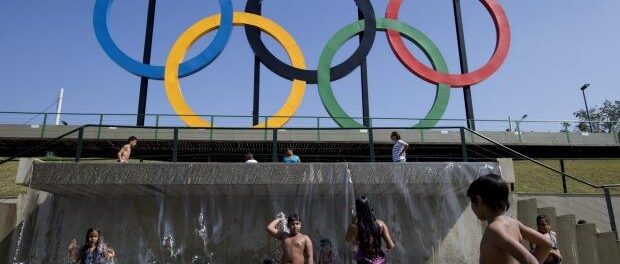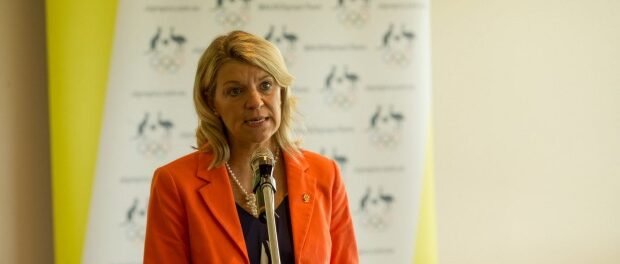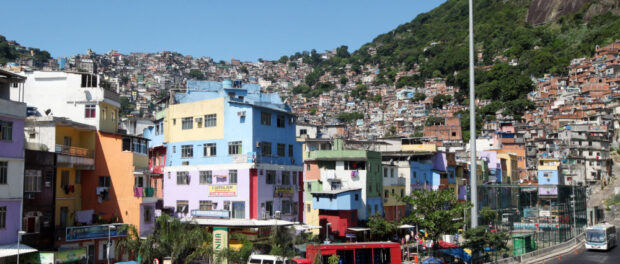
The Australian Olympic Committee plans to ban its athletes and team members from visiting favelas while in Rio de Janeiro for the Olympics. The team at RioOnWatch implores the AOC to reconsider its ban and comments, recognizing the role that Australian media have played in misrepresenting favelas as inherently dangerous places. As it stands, the ban on visiting favelas only contributes to further stigmatizing these communities and justifying damaging policies, at a time when the Olympics offer a great opportunity to learn more about the diverse realities in favelas from the people who know them best—their residents.
In December 2015, the Australian Olympic Committee (AOC) announced it would be “issuing protocols about no-go zones,” banning Australian athletes from certain areas of Rio. AOC Chef de Mission Kitty Chiller stated that “No athletes or team members will be allowed to go into a favela, which a lot of people like to do—to have a look. That will be no-go for us.”
More recently, in February 2016, Chiller was quoted offering further explanation for the Olympic Committee’s security policies: “We don’t want to be Big Brother, we don’t want athletes locked up in their rooms at 8pm but we have a duty of care to look after them.”
AOC spokesman Mike Tancred echoed similar statements: “Our athletes will certainly engage with the residents of Rio, and they will join in the fun on Copacabana beach, but the favelas are areas we cannot control and the personal safety of our athletes must come first.” The language of control and safety here contributes to the stigmatizing, erroneous portrayal of favelas as inherently savage, chaotic, unpredictable and ultimately highly dangerous places.
Ironically, Chiller’s comments in February made reference to the murder of an Argentine tourist in Copacabana as if to say it was a factor contributing to the increased “security risk” of favelas. That specific, tragic incident took place on the beach in a formal South Zone neighborhood, not in a favela. Correlating an isolated violent incident in one location with a generalized security risk in Rio’s hundreds of favela neighborhoods across the city is an example of the misguided prejudice that blights the perception of these communities.
Rio Mayor Eduardo Paes was quick to comment on the AOC’s proposal of the “no-go zones” in the city. “Peace and love, Australia, please!” he told ABC News. He acknowledged that “there is a lot of ignorance about Rio and Brazil, a certain drama of how things are,” but suggested: “Come with more open heart and open minds.” Referring to a perceived overload of critical comments from Australia, the mayor said: “It’s OK to do [the ban]. I don’t complain, but what [I’m saying] is it always comes from Australia.”

The tension between Australian Olympic officials and Paes dates back to April 2014 when the IOC’s Vice President, Australian John Coates, made comments about the preparations for Rio 2016 being the worst he’d ever seen.
Fortunately the Australian Olympic Committee’s view of favelas is not shared by all others in the Oceania region. New Zealand’s Olympic Committee plans to support sport in Rio’s favelas, donating equipment and sending athletes and coaches to work with youth in Mangueira during the Games. New Zealand’s Chef de Mission, Rob Weddell explained the team was “excited about bringing the Olympics to [Mangueira youth] as they otherwise might not get to have seen it and had a role to play in it.” He stressed that athletes need to be careful in all parts of the world, but questioned the need for Australia’s “blanket sort of approach” to favelas.

Favelas in Australian media
International reporting has long perpetuated a sensationalist and stigmatizing portrayal of Rio’s favelas. Generally there has been a positive shift in international media coverage of favelas, introducing more nuance and context, over the last five years. However in recent months the comments of Australian Olympic officials and coverage by Australian media outlets have produced poor portrayals which deserve special attention for reproducing damaging stigmas.
In February 2016, TEN Sport published an AFP report on the Fight For Peace boxing project in Maré with the title, “Olympics give Rio slum kids hope – for survival,” with the opening sentence: “For kids in one of Rio’s toughest slums, the childhood dream of Olympic glory comes with extra motivation: a better chance to stay alive.” The dramatic description of Maré as a “world apart, with areas more like a Mad Max film” and the sensationalist emphasis on the drug traffic and violence give a skewed perception of a community known for its rich history, vibrant civil society and culture.
In November 2015, ABC News published an article on favela tourism which opened: “In the middle of one of Rio’s poorest suburbs a tall black man approaches me and takes my hand. He isn’t about to rob me. Or sell me drugs. He has no plans to steal my organs or give me to a human trafficker. He just wants to show me how to dance.” In this introduction the writer reaffirms every false, negative stereotype about black favela residents and sets the tone for an awkward article which mixes personal perceptions of Rocinha with inaccuracies such as equating the Pacifying Police Unit (UPP) program with a process of “civilization.”
Favelas are not criminal by nature, but are easy targets for criminal groups due to three main factors: historical negligence by the State leaving them vulnerable over a century, economic stagnation from 1975-2005 and again now producing low levels of economic opportunity for residents, and the historical criminalization of poverty which makes acquiring work by favela residents exceptionally difficult. This last factor includes a range of scenarios ranging from the discrimination low-income black favela residents encounter when they apply for jobs, to arbitrary arrests under the military dictatorship, and through to the current UPP program that views favelas to be occupied and “pacified.”
The same ABC News article also bungles its explanation of favelas: “For the uninitiated, favelas are massive shanty towns that have grown up on the outskirts of Rio over more than a century.” In reality, however, favelas are neighborhoods which can be found in every part of the city. In fact, Rocinha itself is a favela in Rio’s wealthy South Zone.
Additionally, favelas are neither shanty towns nor “slums” as the article published in TEN Sport labels them. Shanty towns are defined by the poor quality of building material, so the term is an inaccurate label because the improvised shacks of favela communities’ beginnings have for the most part long been replaced by solid, permanent structures. The key connotation of the word “slum” is squalor, and the word derives from an Irish phrase meaning “a bleak or destitute place.”
As of 2013, however, Brazil’s favela residents were responsible for generating R$38.6 billion per year in commercial activity and 65% of them were in the middle class. Many people who live and work in favelas see them not as bleak, but rather, as Observatório de Favelas director Jorge Barbosa writes, as “fruitful places for the creation of culture” where “their alleys, narrow roads and small squares” are sites of “interactions that weave an extensive fabric of sociability, religion and humanity.”
Looking back further in time, our reports on best and worst international reporting on favelas since 2013 have frequently listed Australian articles among the worst. In December 2014 Fox Sports Australia featured an account of a writer’s visit to Complexo do Alemão. The account lacks any direct perspectives from Brazilian favela residents, which leaves Peacock to make sweeping generalizations that stigmatize the population. “Parents are either desperately trying to make ends meet, or, more likely, trapped by drug addiction,” he writes, insinuating that most parents in the favela are addicts despite no evidence to support it. Meanwhile, imagery of happy but naive kids with bare feet and “worn clothes held together by threads” portrays a level of poverty that does exist in Complexo do Alemão, but which is not pervasive. In fact, the community is increasingly home to lower-middle-class consumers and new businesses, including the area’s first shopping mall. For Peacock, however, the “stories and the sights” he encounters “depress the soul, which is further crushed upon realizing this is just one among thousands like it in Brazil.”
Talking about “the favelas”
The suggestion that favelas are one homogeneous group with identical conditions directly feeds into the AOC’s blanket ban on athletes visiting any of Rio’s favelas. That “the favelas” are considered a single, highly dangerous, inherently criminal place is a violent misrepresentation of the diversity of Rio’s communities. There are over 1,000 favelas in Rio and less than 1% of residents are involved in drug trafficking. In recent months Sky News Australia and 9news.com.au have covered the ongoing evictions battle in Vila Autódromo, the favela located next to the Olympic Park which is an example of a favela that has never had drug trafficking, and where residents have fought for years to remain in the community they love.
While highlighting individual favelas without trafficking is great, assuming all others have trafficking is still inaccurate and problematic: this AFP report published in Australia’s Herald Sun says Vila Autódromo has “none of the usual drug-fueled violence,” which the article implies is “typical of favelas.” Santa Marta resident and tour guide Sheila Souza expressed how frustrating this media tendency is: “I hate when people try to classify us: ‘favela people are like this,’ ‘favela people behave like this’… It’s important to come and have a different reaction, to understand that real life is different.’”
In fact, having developed organically out of an unmet need for housing and without government regulation, a defining characteristic of Rio’s favelas is that each community is entirely unique. Australian journalist Yaara Bou Melhem’s coverage of the city’s transformations for SBS in 2013 stands out as a particularly excellent example of Australian reporting that captured the diversity of Rio’s favelas.
Why Australian perceptions matter
So why do the statements of the Australian Olympic Committee or the language of Australian journalists matter? Because fortifying the stigmatizing notions about Rio’s favelas, whether here in Brazil or thousands of miles away in Australia, also fortifies justification for poorly planned and heavy-handed authoritarian policies. If favelas are seen to be inherently violent, then aggressive police practices are seen as justifiable, and if favelas are seen to be miserable, then forced removals of residents into public housing appear generous interventions to improve people’s lives.
Sensationalist media or comments from high-visibility actors like a national Olympic Committee risk perpetuating a vicious cycle. If they justify policies that neglect favela needs (due to the idea that favelas are ‘no go zones’), then living situations really do get worse for residents, which in turn fuels conditions that will further fortify those stigmas.
As the Olympics draw near, international perceptions matter now more than ever because such mega-events essentially place the host city on a stage for the global audience to critique, and people in Rio—both government officials and regular Cariocas—are hyper-aware of the reputation being shaped in this period of intense media focus. In this context, the blanket ban and comments from the AOC are simply irresponsible, and the Australian media should acknowledge its role in building an image of favelas that led to the Olympic Committee’s decision.
Melbourne seeking to emulate favela qualities
In contrast to the portrayals highlighted above, favelas possess a number of attributes and qualities exalted by urban planners and which cities across the world seek for creating of a sense of community. They have low-rise, high density development; pedestrian orientation; mixed use buildings (homes above shops and workplaces); high use of bicycles and public transportation; residences close to workplaces; and organic architecture (homes that evolve according to their occupants’ needs).
In fact, Australia’s The Age published an article in 2014 recognizing the efficiency created through favela-style development asking, “What can Brazil’s favelas teach us about future cities?”
Melbourne City’s most recent urban plan, PLAN Melbourne considers the need for a model not too different to this where suburbs aim to recreate a sense of community. The Plan calls this a “20 minute city,” an area where residents’ daily activities and resources are accessible within 20 minutes of their homes. Beyond convenience and fostering community, this could also reduce car density and increase walking and bicycle usage for environmental purposes.
Rio’s favelas offer a powerful example of the qualities urban planners in cities such as Melbourne attempt, often with great difficulty, to emulate. Yet the portrayal perpetuated by the blanket ban on Australian athletes visiting favelas, comments by AOC officials, and stigmatizing reports by Australian media outlets combine to obscure the positive qualities and lessons to be learned from these vibrant, diverse urban communities.
We invite members of the AOC as well as Australian Olympic athletes and journalists to visit favelas with some of the favela resident tour guides we’ve featured on RioOnWatch.

